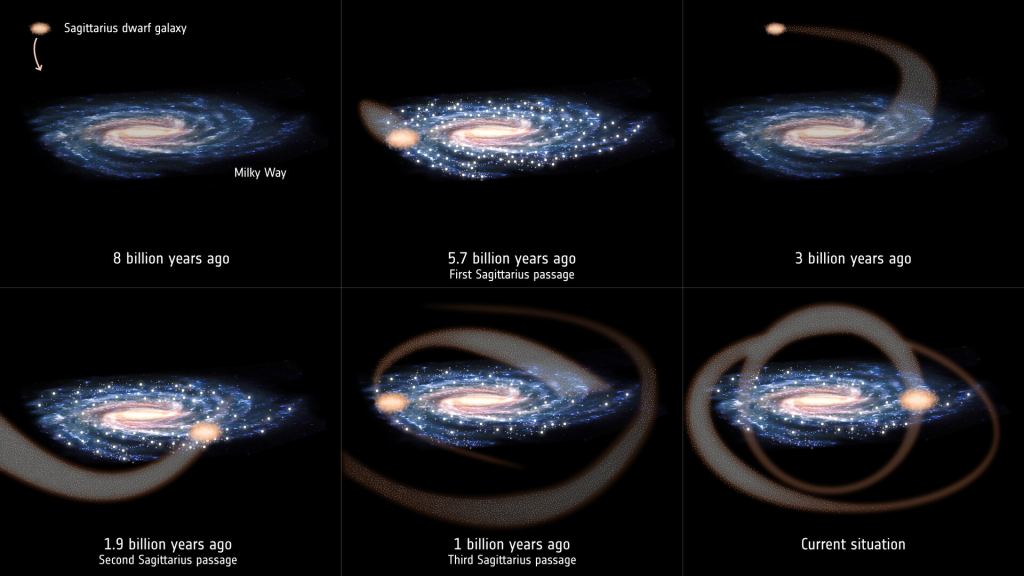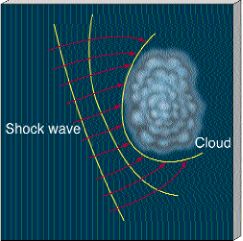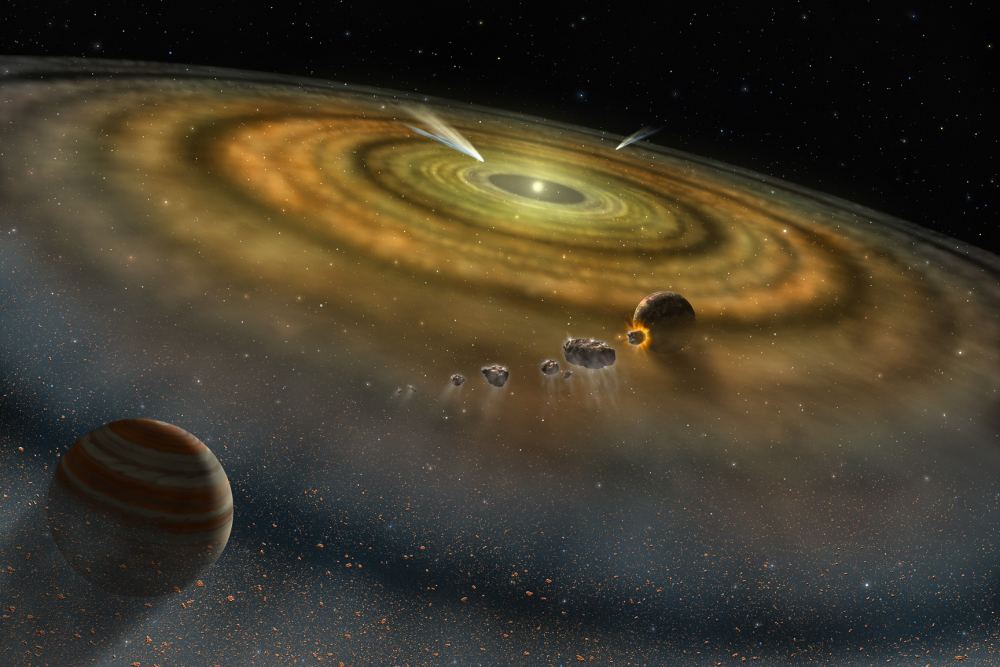The Milky Way has a number of satellite galaxies; nearly 60 of them, depedending on how we define them. One of them, called the Sagittarius Dwarf Spheroidal Galaxy (Sgr d Sph), may have played a huge role when it comes to humans, our world and our little civilization. A collision between the Milky Way and the Sgr d Sph may have created the Solar System itself.
The Sagittarius Dwarf Spheroidal Galaxy was discovered in 1994, and at the time astronomers thought it was the closest dwarf galaxy to the Milky Way. Sgr d Sph is currently about 70,000 light years away from Earth. It travels in a looping polar orbit around the Milky Way.
In 2018, Gaia data showed that the Dwarf Spheroid passed through the Milky Way in the past 300 to 900 million years. Gaia found a pattern of star movement in the Milky Way that pointed to that fact. Now it looks like Sgr d Sph has passed through our galaxy multiple times.
A new study shows that on one of its passes through the Milky Way, about 4.7 billion years ago, it may have created perturbations which led directly to the birth of our Solar System.
The new study is titled “The recurrent impact of the Sagittarius dwarf on the star formation history of the Milky Way.” The lead author is Tomás Ruiz-Lara, a researcher in Astrophysics at the Instituto de Astrofísica de Canarias (IAC) in Tenerife, Spain. The paper is published in the journal Nature Astronomy.

The study is based on data from Gaia, a ESA space telescope. Gaia’s mission is to create a 3D chart of the stars in the Milky Way. By mapping the velocity and position of about 1 billion stars in the Milky Way, Gaia hopes to reveal the stellar composoiton of the galaxy, and how the galaxy formed and evolved over time.
Gaia data has shown the impact that Sag. Dwarf Spheroid has had on the Milky Way over billions of years. According to the data, the dwarf has collided with the Milky Way at least three times in the past 6 billion years. And those rendezvous might have triggered some major episodes of star formtion, including the Sun itself.

“It is known from existing models that Sagittarius fell into the Milky Way three times – first about five or six billion years ago, then about two billion years ago, and finally one billion years ago,” said lead author Ruiz-Lara in a press release.
“When we looked into the Gaia data about the Milky Way, we found three periods of increased star formation that peaked 5.7 billion years ago, 1.9 billion years ago and 1 billion years ago, corresponding with the time when Sagittarius is believed to have passed through the disc of the Milky Way,” said Ruiz-Lara.
Astronomers have a lot of data and models at their disposal, including on stellar evolution. The authors behind this work looked at existing stellar evolution models, and compared it to stars within about 6500 light years around our Solar System. They looked at the stars’ luminosity, color, and distances. According to their work, all of that data indicated an encounter with the Sagittarius Dwarf Spheroidal Galaxy.
“The Sun formed at the time when stars were forming in the Milky Way because of the first passage of Sagittarius.”
Carme Gallart, Co-Author, IAC
“At the beginning you have a galaxy, the Milky Way, which is relatively quiet,” Ruiz-Lara said. “After an initial violent epoch of star formation, partly triggered by an earlier merger as we described in a previous study, the Milky Way had reached a balanced state in which stars were forming steadily. Suddenly, you have Sagittarius fall in and disrupt the equilibrium, causing all the previously still gas and dust inside the larger galaxy to slosh around like ripples on the water.”
These ripples change the density of gas in some regions, and lower it in others. As gas density increases, it triggers star formation, in the same way that the shock-waves from supernovae can trigger star formation.
When a shock wave encounters an interstellar cloud of gas, it doesn’t push it out of the way. The outside is thinner material than the dense interior of the cloud, so the shock wave travels around the outside of the cloud, eventually pushing in from all sides and compressing the material, sometimes enough to form stars.

“It seems that not only did Sagittarius shape the structure and influenced the dynamics of how stars are moving in the Milky Way, it has also led to a build-up of the Milky Way,” says Carme Gallart, a co-author of the paper, also of the IAC. “It seems that an important part of the Milky Way’s stellar mass was formed due to the interactions with Sagittarius and wouldn’t exist otherwise.”
So not only has the Sag. Dwarf Spheroid galaxy changed the structure and movement of stars in the Milky Way, it may have caused the formation of a portion of them. Including our Sun. While at the moment, there’s no absolute conclusion that the close encounter did in fact form the Sun, it’s a distinct possibility.
“The Sun formed at the time when stars were forming in the Milky Way because of the first passage of Sagittarius,” says Gallart. “We don’t know if the particular cloud of gas and dust that turned into the Sun collapsed because of the effects of Sagittarius or not. But it is a possible scenario because the age of the Sun is consistent with a star formed as a result of the Sagittarius effect.”
But the evidence is compelling. Whether or not scientists can point to the specific stars that were born from the interaction between the Milky Way and the Sagittarius Dwarf Spheroidal Galaxy is not necessarily the most compelling thing about the study. The compelling thing is that a low-mass satellite can cause star formation in its much larger companion.
“The possibility that a satellite dwarf galaxy considerably less massive than its host is able to induce repeated massive events of star formation involving an important part of its disk is striking, the authors write in their paper. “All evidence seems to suggest that recurrent interactions between the Milky Way and Sgr dwarf galaxy are behind such enhancements <in stellar formation>. These findings imply that low mass satellites, not only affect the Milky Way disk dynamics, but also are able to trigger notable events of star formation throughout its disk.”
This study speaks to the enormous contribution the Gaia mision has made in our understanding of the Milky Way. Launched in 2013, it’s initial five-year mission ended in September 2019. Now it’s been extended to the end of 2022. There’ve been two data releases from Gaia, and countless papers based on that data.
“Some determinations of star formation history in the Milky Way existed before based on data from ESA’s early 1990s Hipparcos mission,” said ESA Gaia project scientist Timo Prusti. “But these observations were focused on the immediate neighbourhood of the Sun. It wasn’t really representative and so it couldn’t uncover those bursts in star formation that we see now.”

This map shows the density of stars observed by Gaia in each portion of the sky. Brighter regions indicate denser concentrations of stars, while darker regions correspond to patches of the sky where fewer stars are observed. The two large white patches below and to the right are the Large and Small Magellanic Clouds. Credit: ESA / Gaia / DPAC / A. Moitinho & M. Barros, CENTRA – University of Lisbon.
But Gaia’s reach has changed that. “This is really the first time that we see a detailed star formation history of the Milky Way. It’s a testament to the scientific power of Gaia that we have seen manifest again and again in countless ground-breaking studies in a period of only a couple of years.”

